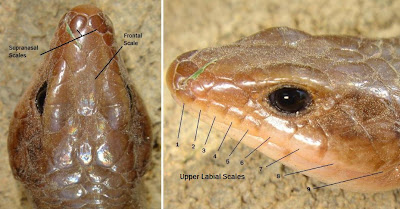Herp Friday: Broadhead Skink, Eumeces laticeps
This broadhead skink, Eumeces laticeps, has been seen hanging around my house several times in the last few weeks. I was able to get some extreme close-ups of it one day when it was cool outside and he was a little sluggish. I had a fairly easy time identifying it simply based on its appearance, but to be certain, I used the key to the lizards of Arkansas contained in the excellent book, The Amphibians and Reptiles of Arkansas by Stanley Trauth et al
1. Four legs present.
2. Body scales smooth, shiny and overlapping. (That places them in the family Scincidae).
3. Frontal scale rectangle shaped; supranasal scales present (see below); lower eyelid without transparent disk. (not pictured)
4. Dorsal and lateral scales in parallel rows with the long axis of the body (2nd picture above).
5. Chin with 2 postmental scales. (not pictured)
6. Eight or nine upper labials; no postlabial or if present one or two small postlabials, the sixth labial is the first to contact the orbit (see below); maximum SVL over 85 mm (didn't measure)........Broadhead skink, Eumeces laticeps
These are relatively large lizard for this area. The adults are usually tan or brown except for the head which may turn red or orange in males during breeding season. This lizard's home range is essentially the southeastern quarter of the U.S., which overlaps with that of the Five-lined skink. These species have very similar appearances as hatchlings and can easily be confused. Some people incorrectly call broadhead skinks "scorpions", probably because they may bite if mishandled, though their bite is not poisonous.
Don't forget to check out Modulator's Friday Ark.
Labels: Friday Ark, photography, wildlife, zoology













